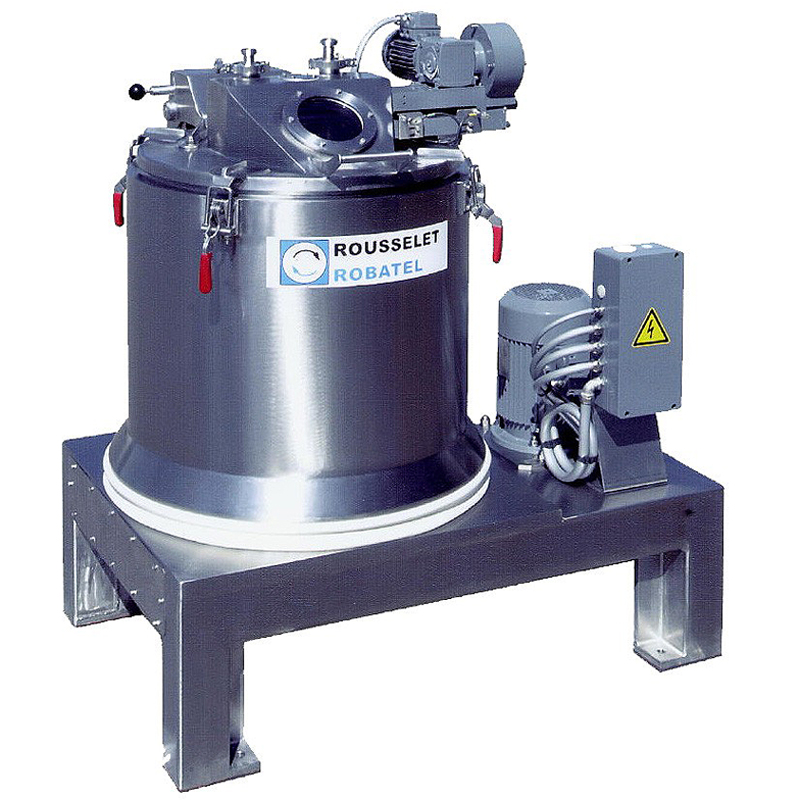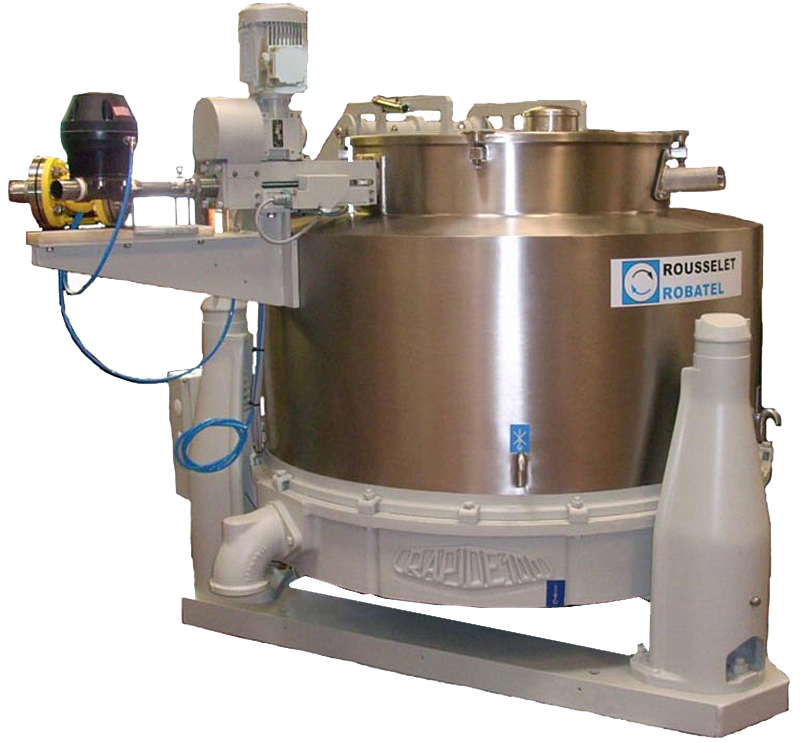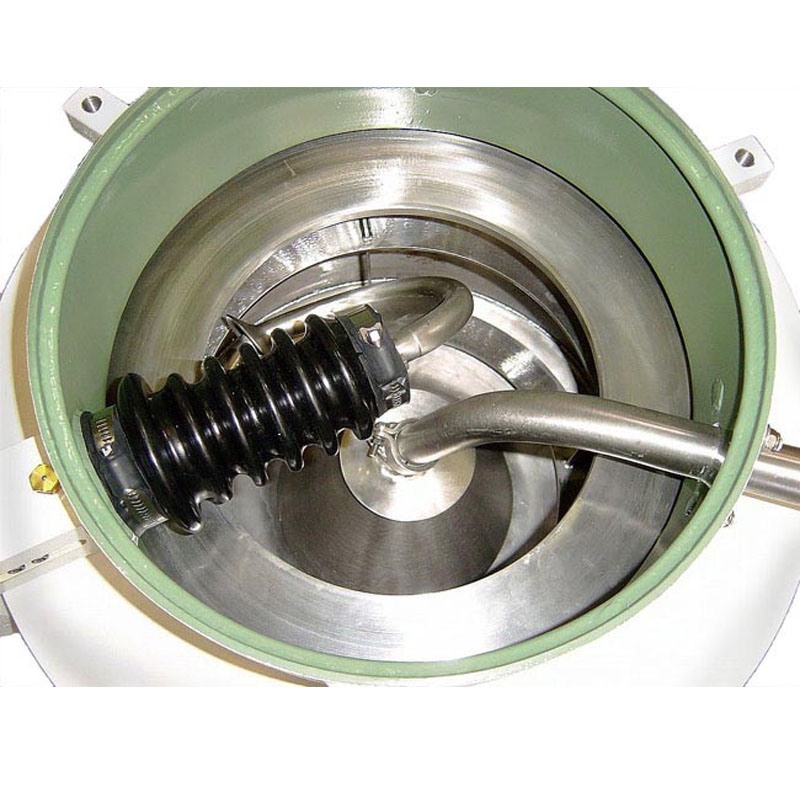TYPES OF APPLICATIONS
– Chemical, pharmaceutical and biotechnology industries:
Vaccines, collagen products, separation of enzymes from macerated solutions, separation and purification of solids (e.g. hydroxides), clarification of dyes, separation of pigments, concentration of micro-algae, ...
– Food industry: clarification of frying oil used in industrial confectionery lines, plant decoctions, gum arabic solutions, decantation of wine yeast…
– Metallurgy and metal industry: recovery of carbide powder after grinding, metal powders from solvent solutions, cleaning and recycling of electrolyte in electrochemical processing lines…
– Environment: clarification of glass polishing and shaping fluids, electrolytic oxidation baths, detergent products and lyes…
PRINCIPLE OF OPERATION
– The centrifuge bowl rotates at the selected speed or maximum speed
– Once the speed is achieved, the solution is fed into the bowl as uniformly as possible through the feed pipe. Under the influence of centrifugal force, the heavier phase will move to the walls of the bowl
– The "clarified liquid" phase is continuously discharged:
Or overflowing over the top of the bowl
Or via a pre-positioned skimmer tube to optimize the usable bowl volume
– When the bowl is already full of solids deposits, the slurry feed stops
– For centrifuges equipped with a skimmer tube, move it into the bowl to remove the remaining lighter phase
– Sediment can be removed:
Or with a rotating bowl through the skimmer pipe (if the centrifuge is equipped with it and when the consistency of e.g. fine solids allows it and the solids can be pumped out with a pump,
Either with the bowl stopped, then unloading manually (by the operator using a scraper), or using a removable cage (without or with a textile bag containing solids)
NOTE 1 For centrifuges without a skimmer tube, residual liquid and solid phases can only be removed by stopping the bowl and opening the lid
Basic diagram for separation into 3 phases (1 solid / 2 liquids - light and heavy).
NOTE 2 In the case of extraction and purification of solids, the centrifuge operates as a batch centrifuge: After prior phase separation, re-silification by feeding the solids rinsing liquid and repeated decantation. This procedure can be repeated by rinsing several times...
MAIN SPECIFICATIONS
– Centrifuge with a vertical axis
– Rigid type (DRA / DRC-Vx) or suspended in a three-column centrifuge (DSC)
– Centrifuge rotary driven by an axial motor (DRA) or side mounted with belt transmission (DRC-Vx / DSC)
– Electric braking – countercurrent (DRA) or inverter (DRC-Vx) or mechanical (disc) braking (DSC)
– Independent power supply and control panel
– Safety devices compliant with European standards
OPTIONAL FUNCTIONS AND EQUIPMENT... depending on the centrifuge model and applications
– Bowl: cylindrical or conical, with reinforcing rims or made of solid material, without or with (fixed or removable) blades, without or with separator, with quick release mechanism, with holes (filled with screws) in the upper part of the bowl (for processing different usable volumes) or in the lower plate of the bowl (in order to drain the remaining liquid by gravity) after stopping the bowl
– Manufacturing materials and finishing: cast iron, carbon steel, various grades of stainless steel, alloys, titanium, anti-rust sprays, anti-corrosion coatings (HALAR), specific (“food” or “pharmaceutical”) polishing and finishing of some (or all) parts in contact with the product
– Removal of separate phases: through a bowl overflow, through a pipe or skimmer pipes (1 or 2) operated manually using a manipulation wheel or a geared motor, placed on the centrifuge body or on its cover, without or with a sediment selector, and manually or using a removable cage for sludge that cannot be pumped out
– Outer casing: with full or partial opening and a suitable cover with manual, pneumatic or hydraulic opening (depending on the opening of the housing, diameter and weight of the cover and its accessories)
– Electrical components: waterproof, explosion-proof, compliant with the ATEX directive
Centrifuge tightness: optionally gas tight for gas without pressure or under pressure (in a nitrogen shield)
– Suspension feeding: through a special supply pipe located on the shell or cover
– Other additional equipment
- Speed change depending on the inverter drive (DRA-Vx, DSC-Vx)
- Rotor grounding between the fixed and rotating parts of the centrifuge and control of the hottest point of the centrifuge (ATEX compliance)
- Tube (optionally with nozzles) for removing sediment from the bowl walls (at low speed) •CIP (Cleaning In Place) nozzles
- Double jacket for cooling or heating liquids, with optional centrifuge insulation •Smaller centrifuges can be designed to be sterilized (at a maximum pressure of 1.2 bar) after stopping
- Smaller centrifuges can be placed on a base plate or cart (for easy handling and portability)
CENTRIFUGAL DECANTERS WITH REMOVABLE SLUDGE DRAINAGE CAGE TYPE DRC-Vx K / DSC-K
For easier, faster and complete removal of the thick cake (sedimentary phase)
In this version, the rimless bowl receives a removable cage designed with plates
The removable cage can be wrapped in a textile bag to prevent loss of sediment in the event of cake collapse (DRC-Vx KF / DSC-KP types)
MODEL TABLE
| BIN | |||||||||
| MODEL | TURNOVER | DIAMETER | HEIGHT | USABLE CAPACITY | SLUDGE CAPACITY | HYDRAULIC FLOW | ENGINE POWER | WEIGHT | G FORCE |
| rpm | mm | mm | L | L | L/min | kW | kg | G | |
| DRA/DRC 40 | 1500/3000 | 400 | 255 | 17 | 7 | 17/25 | 1,1-4 | ≥26 | 2010 |
| DRA/DRC 50 | 1500/2750 | 500 | 320 | 40 | 18 | 25/40 | 2,2-5,5 | ≥310 | 2110 |
| DRC 60 | 870/2600 | 600 | 350 | 60 | 27 | 40/65 | 4-9 | ≥550 | 2265 |
| DSC/DRC 70 | 1300/1850 | 700 | 350 | 80 | 35 | 65/90 | 5,5-7,5 | ≥680 | 1335 |
| DSC/DRC 85 | 1100/1650 | 850 | 470 | 180 | 80 | 110/140 | 7,5-15 | ≥1350 | 1290 |
| DSC/DRC 100 | 1000/1350 | 1000 | 500 | 250 | 100 | 150/180 | 11-15 | ≥1650 | 1015 |
| DSC/DRC 120 | 900/1150 | 1200 | 600 | 360 | 150 | 220/250 | 22 | ≥2300 | 885 |
| DSC/DRC 150 | 750/1000 | 1500 | 620 | 530 | 250 | 380/450 | 37 | ≥4000 | 835 |
| REMOVABLE | CAGE | DECANTERS | |||||||
| DRC 50 K | 1500/2250 | 500 | 320 | 40 | 18 | 25/40 | 3-7,5 | 450 | 1415 |
| DSC 70K | 1100/1600 | 700 | 350 | 80 | 35 | 65/90 | 7,5-9 | 600 | 1000 |
| DSC 85K | 1000/1450 | 850 | 470 | 180 | 80 | 110/140 | 11-15 | 1200 | 1000 |
| DSC 100K | 900/1300 | 1000 | 500 | 250 | 100 | 150/180 | 15-18,5 | 1600 | 945 |
Permissible flows depend on the viscosity of the suspension, the degree of emulsification and on the differences in the specific gravity of the phases and the flow ratio between the 2 phases













